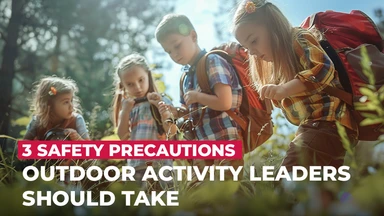4 Safety tips you need to know when Bushwalking


Bushwalking is a popular activity in Australia. And it's not just popular with Aussies.
Lovers of trekking and backpacking come from North America as well as ramblers from the UK, drawn to the gorgeous coastal wilderness and outback of our wide brown land.
The bush, its vastness and its mysteries, are not to be trifled with. Before you lace on the boots, take note of the following safety guidelines…
It's not advisable to go bushwalking in extreme temperatures, lest you suffer from heat stroke or heat exhaustion.
Atmospheric conditions can also change at the drop of a hat and expose otherwise unseen dangers on the trail.
Before heading out, make sure you'll be able to tolerate the expected temperatures while walking. And watch for pertinent announcements, such as bushfire or flash flood warnings in the case of forecasted storms.
Bushwalking alone is not recommended, regardless of your hiking experience. There is safety in numbers.
Going out in groups of three or more is recommended. Buddying up is much safer and allows strategies to be formulated to deal with common emergency situations.
Aside from buddying up when bushwalking, it’s also advisable to outline your plans to a person who will not be participating. This could be a partner, family member, or another friend. Tell them what time you’re leaving, about your planned route, and when you expect to be back.
Another option is to go bushwalking with an organised association or group. They would be familiar with the trails and likely to be trained in first aid, which means they will be responsible company and generally well-prepared should a difficult situation arise.
When you buddy up, make sure you stick together. The entire purpose of buddying up is lost if a member of the party goes astray.
Bushwalking usually means the trails are not marked. Unless you’re familiar with the area, do your research and take time to plan a route that will be appropriate for the fitness level of you and your walking party.
A printed map and a compass are the most reliable guides when you need direction. Mobile phones and digital devices depend on signal strength and battery power and can fail midway through your hike.
Once you’ve decided on your route, do some research on the terrain to identify any potential hazards, such as slippery rocks, boulders, or unmarked cliffs. There’s no such thing as being too careful.
Now that you’ve taken stock of the weather and have a good idea of what the terrain might look like, it’s time to gear up.
A first-aid kit is a high priority item and should be at the top of any adventurer's list.
Rough terrain will need sturdy shoes. You want adequate foot support and a good amount of grip in order to reduce your risk of injury. Lightweight sports shoes are not recommended for bushwalking.
Wear your clothes in layers to make it easy to add or subtract a layer in response to temperature changes on the trail. Long-sleeved, lightweight shirts and trousers are ideal for bushwalking as they help protect against scratches and stings.
Put on a liberal amount of sun protection before heading out. A hat will also prove valuable out on the trail.
Each person should carry at least 2 litres of water with them. As for food, stick to high-energy options that keep well, such as fruit, raw vegetables, nuts, and energy bars.
Never go bushwalking while inebriated or otherwise under the influence.
This list is by no means comprehensive. But it should satisfy the basic needs of first-time bushwalkers looking to try one of the easier trails in a national park.
While on a walk, please think of others and make sure you keep the surroundings clean and pick up after yourself.
Finally, in case of emergency, call triple-zero (000) for immediate assistance.

October 1, 2024
Almost every job involves using the body to carry out some type of manual task. Some tasks may be hazardous, causing injuries such as musculoskeletal disorders (MSDs). Knowing how to manage them is a legal responsibility of all workplaces.

January 10, 2024
In Australia, workplace safety is a top priority, and First Aid plays a crucial role in ensuring the well-being of employees. Workplaces are expected to adhere to specific regulations and guidelines outlined by Safe Work Australia. How does your workplace stack up?

November 24, 2023
No matter how experienced you are as an outdoor activity leader, there are some things you should always do to keep your group safe. Nature can be unpredictable, and so it’s best to be prepared.